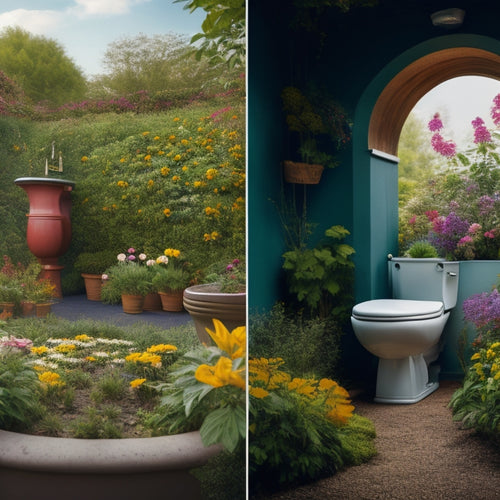
Why Choose Earth-Friendly Roofs for Passive Homes?
Share
As you design your passive home, choosing an earth-friendly roof is essential for minimizing your carbon footprint and maximizing long-term savings. This decision not only reduces your reliance on fossil fuels but also provides a sustainable, energy-efficient solution that pays for itself over time. By incorporating renewable energy sources, optimizing thermal mass, and selecting eco-friendly materials, you can create a roof that regulates indoor climate, reduces energy bills, and increases your home's value. As you explore the world of sustainable roofing, you'll reveal a wealth of innovative solutions that harmonize style, comfort, and environmental responsibility, and learn how to turn your passive home into a guiding light of eco-friendliness.
Key Takeaways
- Earth-friendly roofs reduce environmental impact and promote long-term cost savings for passive homes.
- They utilize renewable energy sources like solar power, leading to significant annual fuel cost savings.
- Green roofs enhance water management, reduce stormwater runoff, and provide additional insulation, decreasing heating and cooling needs.
- Earth-friendly roofs increase home value, reduce excessive energy bills, and support eco-friendly practices by regulating indoor climate.
- They can integrate high-efficiency solar panels, radiant barrier systems, and sustainable insulation materials to maximize energy efficiency and minimize carbon footprint.
Benefits of Sustainable Roofing
Regularly, homeowners and builders alike are recognizing the importance of sustainable roofing in constructing passive homes that not only reduce environmental impact but also provide long-term cost savings.
You're likely considering sustainable roofing options for your passive home, and you're not alone. In addition to the environmental benefits, adopting renewable energy sources, such as solar power, can lead to significant reductions in greenhouse gas emissions and even 70% annual fuel cost savings.
Green roofing, in particular, offers a unique set of benefits. By incorporating vegetation into your roof design, you can improve water management, reduce stormwater runoff, and even create habitats for local wildlife.
Additionally, green roofs provide an extra layer of insulation, reducing the need for heating and cooling. By choosing sustainable roofing, you're not only doing your part for the environment, but you're also investing in your home's long-term value and your own freedom from excessive energy bills.
Energy Efficiency in Roof Design
When designing a roof for your passive home, you'll want to focus on maximizing energy efficiency to reduce your carbon footprint and energy bills.
To achieve this, you'll need to examine three key elements: thermal mass benefits, which absorb and release heat; insulation material options, such as fiberglass, cellulose, or spray foam; and radiant barrier systems, which reflect heat rather than absorb it.
High-efficiency solar panels can also be integrated into your roof design, allowing you to harness renewable energy and reduce your reliance on fossil fuels.
Thermal Mass Benefits
Your roof's thermal mass plays a significant role in regulating the indoor climate of your passive home. It absorbs and releases heat, moderating temperature fluctuations and maintaining a comfortable living space.
A roof with high thermal mass has high thermal conductivity, allowing it to efficiently absorb heat during the day and release it at night. This heat retention capability reduces the need for heating and cooling, resulting in significant energy savings.
By incorporating materials with high thermal mass into your roof design, you can create a more energy-efficient and sustainable living space that aligns with your values of freedom and environmental responsibility.
Moreover, integrating solar-powered fast charging hubs into your roof design can provide an additional source of renewable energy, supporting your commitment to eco-friendliness.
Insulation Material Options
In tandem with thermal mass, insulation plays an essential role in maintaining a comfortable indoor climate and reducing energy consumption in passive homes. You have several eco-friendly options to choose from, each with its unique benefits and characteristics.
| Insulation Material | Eco-Friendliness |
|---|---|
| Recycled Denim | High (made from recycled jeans) |
| Natural Wool | High (sustainable, renewable resource) |
| Cellulose Fiber | High (made from recycled paper products) |
| Soy-Based Foam | Medium (biodegradable, but may contain chemicals) |
| Cotton Batt Insulation | Medium (natural fibers, but may contain additives) |
When selecting an insulation material, consider factors like R-value, cost, and installation requirements. By choosing an earth-friendly insulation option, you'll not only reduce your carbon footprint but also create a healthier, more comfortable living space.
Radiant Barrier Systems
Optimize your roof's energy efficiency with radiant barrier systems, an essential component of passive home design. By reducing heat gain in summer and heat loss in winter, radiant barriers considerably improve your home's energy efficiency. You can expect a radiant barrier's effectiveness to reduce your cooling costs by up to 10%.
Additionally, incorporating renewable energy solutions like solar panels can provide supplementary power and extend your home's energy independence.
When it comes to radiant barrier installation, it's vital to get it right. Install the barrier in the attic space, typically directly below the roofing material, to maximize its performance. Confirm a snug fit to prevent air gaps that can compromise the system's effectiveness.
With proper installation, radiant barriers can be a transformative factor in your passive home's energy efficiency.
Environmental Impact of Roof Materials
When you're selecting a roof material for your passive home, you're not just choosing a product - you're supporting an entire production process.
You'll want to take into account the environmental cost of material extraction methods, which can range from sustainable forestry practices to energy-intensive mining operations.
By integrating renewable energy sources, such as solar power integration, into your building design, you can offset the carbon footprint of your roof material.
Additionally, adopting energy-efficient solutions can lead to substantial energy bill savings and a reduced environmental impact.
Material Extraction Methods
You're likely familiar with the environmental impact of roof materials, but have you considered the extraction methods behind them?
The way materials are extracted can greatly affect the environment. For instance, quarrying for natural stone or mining for metals can lead to habitat destruction and water pollution.
Sustainable sourcing is essential to minimize the ecological footprint of your roof. Look for suppliers that employ responsible extraction technologies, reducing waste and conserving resources.
Some companies are now using innovative methods, such as recycled materials or low-impact mining techniques.
Carbon Footprint Analysis
Beyond material extraction methods, it is essential to scrutinize the carbon footprint of your roof materials, as this is a significant component of your passive home's overall environmental impact. When selecting earth-friendly roof materials, you must consider the embodied energy, transportation emissions, and end-of-life disposal or recycling impacts.
| Material | Carbon Footprint (kg CO2e/m²) |
|---|---|
| Asphalt Shingles | 15.6 |
| Clay Tiles | 24.8 |
| Metal Roofing | 12.3 |
| Vegetated Roof | 6.1 |
A lifecycle assessment can help you identify areas for improvement and inform your carbon offset strategies. By understanding the carbon footprint of your roof materials, you can make informed decisions that reduce your passive home's environmental impact and align with your values of freedom and sustainability.
Waste Generation Rates
Now that you've considered the carbon footprint of your roof materials, it's time to examine another important aspect of their environmental impact: waste generation rates.
As you choose materials for your passive home, remember that waste reduction is vital. Some materials produce massive amounts of waste during production, installation, and disposal.
Look for manufacturers with recycling initiatives in place to minimize waste. For instance, some companies recycle old roofing materials to create new ones, reducing landfill waste.
When evaluating materials, consider their end-of-life recyclability and reusability. By selecting materials with low waste generation rates, you'll not only reduce environmental harm but also support a more circular economy.
Passive House Roofing Requirements
Building a passive house demands a thorough approach, and the roof plays an essential role in achieving the desired energy efficiency. You must guarantee your roof meets specific requirements to qualify as a passive house.
Roofing regulations and building codes vary by region, but they all aim to minimize heat loss and maximize energy efficiency. For instance, the International Passive House Standard requires roofs to have a U-value of 0.15 W/m²K or lower. This means you'll need to select materials with high insulation values, such as foam board or fiberglass batts.
Additionally, you'll need to verify airtightness and watertightness to prevent heat loss and moisture intrusion. By meeting these requirements, you'll be well on your way to creating a passive house that provides freedom from high energy bills and environmental guilt.
Cost Savings of Cool Roofs
Frequently, homeowners overlook the significant cost savings that cool roofs can provide, but incorporating this earth-friendly feature into your passive house design can lead to substantial long-term benefits.
By investing in cool roof technology, you'll reap the rewards of reduced energy consumption and lower utility bills. This smart investment will pay off in the long run, allowing you to enjoy your passive home while saving money.
-
Reduced energy consumption: Lower cooling demands mean less energy spent on air conditioning.
-
Extended roof lifespan: Cool roofs are less prone to degradation from heat, extending their lifespan.
-
Increased property value: Energy-efficient features like cool roofs enhance your property's value.
-
Reduced maintenance: Cool roofs require less maintenance due to their reflective properties.
-
Government incentives: Many governments offer rebates and tax credits for energy-efficient upgrades like cool roofs.
Future of Eco-Friendly Roofing
Hundreds of innovative eco-friendly roofing solutions are emerging, ready to reshape the way you think about passive house design.
As you look to the future, it's crucial to evaluate the trends that will shape the industry. You'll see a rise in integrated photovoltaic systems, allowing you to utilize solar energy while reducing your carbon footprint.
Other future trends include advanced materials like translucent solar panels, which can generate electricity while still allowing natural light to pass through.
With innovative technologies like these, you'll have more freedom to design your passive home with both sustainability and style in mind.
Frequently Asked Questions
Can Earth-Friendly Roofs Be Used on Existing Homes?
You can definitely retrofit earth-friendly roofs onto existing homes, exploring various installation options that suit your needs. The material benefits, such as improved insulation and durability, will enhance your home's comfort and sustainability.
Are There Any Government Incentives for Eco-Friendly Roofing?
As you commence on an eco-friendly roofing adventure, you'll be thrilled to uncover that you're eligible for government rebates and tax credits, which will help offset the costs, giving you the freedom to choose sustainable living without breaking the bank.
How Do Earth-Friendly Roofs Perform in Extreme Weather?
You'll find earth-friendly roofs excel in extreme weather, thanks to their exceptional insulation properties, which maintain a consistent indoor climate, while their sustainability benefits shine through in reduced energy consumption and a lower carbon footprint.
Can I Install an Earth-Friendly Roof Myself?
Ha! You think you're a roofing expert? Probably not, but you can still try. However, unless you're familiar with specialized installation techniques and DIY materials, it's best to leave earth-friendly roof installation to the pros – your wallet and roof will thank you.
Are Earth-Friendly Roofs More Prone to Maintenance Issues?
You'll find that earth-friendly roofs, made with eco-friendly materials, might require more frequent maintenance due to their organic nature, but with regular checks, you'll be able to identify issues early, reducing maintenance frequency and ensuring your roof lasts longer.
Related Posts
-

Why Transform Human Waste Into Garden Gold?
By changing human waste into garden gold, you'll reduce waste management costs, support sustainable agriculture, and ...
-

7 Smart Air Purification Hacks for Energy-Savvy Homes
You can notably improve your indoor air quality while minimizing energy consumption by implementing strategic air pur...
-

3 Eco-Friendly Automated Blinds for Contemporary Living
You're looking to raise your living space with automated blinds that not only exude contemporary style but also align...


